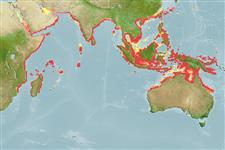Cephalopoda |
Octopoda |
Octopodidae | Octopodinae
Environment: milieu / climate zone / depth range / distribution range
Ecology
Benthic; depth range 0 - 50 m (Ref. 275). Tropical; 28°N - 23°S, 35°E - 155°E (Ref. 275)
Indo-West Pacific: from Mozambique to China and the Philippines.
Length at first maturity / Size / Weight / Age
Maturity: Lm ? range ? - ? cm Max length : 100.0 cm TL male/unsexed; (Ref. 96968); max. published weight: 2.0 kg (Ref. 275)
A moderate to large species characterized by: 1) water pouches, 2) an arm formula of I.II.III.IV, 3) a rudimentary ligula without a calamus in males, and 4) little apparent skin sculpture.
It's mantle length is 18 cm (Ref. 96968). It is a bottom-dwelling species, found mainly in intertidal coralline areas (Ref. 128042). Occurs in shallow subtidal areas on soft sediment substrates (Ref. 96968).
Life cycle and mating behavior
Maturity | Reproduction | Spawning | Eggs | Fecundity | Larvae
Members of the class Cephalopoda are gonochoric. Male and female adults usually die shortly after spawning and brooding, respectively. Mating behavior: Males perform various displays to attract potential females for copulation. During copulation, male grasp the female and inserts the hectocotylus into the female's mantle cavity where fertilization usually occurs. Life cycle: Embryos hatch into planktonic stage and live for some time before they grow larger and take up a benthic existence as adults.
Roper, C.F.E., M.J. Sweeney and C.E. Nauen 1984 FAO Species Catalogue. Vol. 3. Cephalopods of the world. An annotated and illustrated catalogue of species of interest to fisheries. FAO Fish. Synop. 125(3):277p. Rome: FAO. (Ref. 275)
IUCN Red List Status
(Ref. 130435: Version 2025-1)
CITES status (Ref. 108899)
Not Evaluated
Not Evaluated
Threat to humans
Human uses
Fisheries: commercial
| FishSource |
Tools
More information
Trophic EcologyFood items (preys)
Diet composition
Food consumption
Predators
PhysiologyOxygen consumption
Human RelatedStamps, coins, misc.
Internet sources
Estimates based on models
Preferred temperature
(Ref.
115969): 25.2 - 29.1, mean 28.3 (based on 1338 cells).
Resilience
High, minimum population doubling time less than 15 months (K=0.91).
Fishing Vulnerability
Low to moderate vulnerability (35 of 100).
